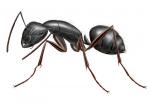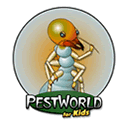Carpenter Ant
| Appearance |
|---|
 Among the largest of ants, 1/4- to 3/8-inch long. Color varies
depending on species, from red to black or a combination. The most
common species is black. Among the largest of ants, 1/4- to 3/8-inch long. Color varies
depending on species, from red to black or a combination. The most
common species is black. |
| Habitat |
|
Carpenter ants get their name because they excavate wood in order to build their nests, leaving hollowed-out tunnels. These colonies require a constant source of water to survive, and are often found in wet, decayed wood such as dead limbs and tree stumps. Inside, they can be found in wet, poorly ventilated spaces such as crawl spaces or attics. While carpenter ants don't eat wood, their excavations pose a property threat, making ant control imperative. In the spring, winged reproductive ants called swarmers fly out to start new colonies. Colonies can contain up to 50,000 workers. |
| Diet |
| Will feed on nearly anything people eat, particularly sweets and meats. The favorite food of adult carpenter ants is the sweet "honeydew" produced by plant-feeding insects, such as aphids, scales, and mealybugs. Carpenter ants also feed on other insects. |
| Control |
|
Successful carpenter ant control depends on eliminating the parent colony, which is usually located outdoors. Finding and treating as many nests (satellite colonies) as possible is the key to carpenter ant control. Store firewood away from your house, trim dead limbs from trees, and remove stumps and lumber from around the house. A frequently overlooked ant control measure is to make sure that all plumbing or roof leaks are sealed. |



